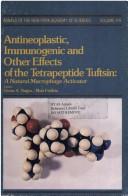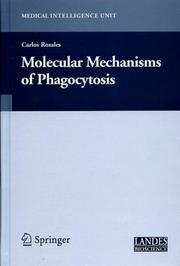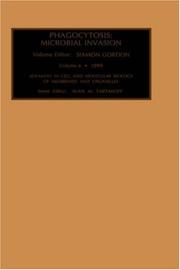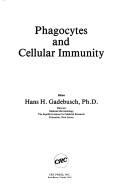| Listing 1 - 9 of 9 |
Sort by
|

ISBN: 0897662334 9780897662338 Year: 1983 Publisher: New York (N.Y.): New York Academy of Sciences,
Abstract | Keywords | Export | Availability | Bookmark
 Loading...
Loading...Choose an application
- Reference Manager
- EndNote
- RefWorks (Direct export to RefWorks)
Book
ISBN: 9535127276 9535127268 953514152X Year: 2016 Publisher: IntechOpen
Abstract | Keywords | Export | Availability | Bookmark
 Loading...
Loading...Choose an application
- Reference Manager
- EndNote
- RefWorks (Direct export to RefWorks)
Autophagy in Current Trends in Cellular Physiology and Pathology is addressed to one of the fundamental molecular mechanisms - autophagy- evolutionarily adopted by cells for processing of unnecessary or malfunctioned constituents and shaping intracellular structures, adjusting them to environmental conditions, aging, disease, neoplasia, and damages over their life period. Particular attention is paid to autophagy-mediated barrier processes of selective sequestration and recycling of impaired organelles and degradation of invading microorganisms, that is, the processes sustaining intrinsic resistance to stress, tissue degeneration, toxic exposures, and infections. The presented topics encompass personal experience and visions of the chapter contributors and the editors; the book chapters include a broad analysis of literature on biology of autophagy.
Phagocytosis. --- Cytology. --- Autophagy. --- Cell biology --- Cellular biology --- Biology --- Cells --- Antigen-antibody reactions --- Endocytosis --- Immune response --- Immunology --- Phagosomes --- Pinocytosis --- Reticulo-endothelial system --- Tuftsin --- Autophagic vacuoles. --- Autophagocytosis --- Life Sciences --- Microbiology --- Genetics and Molecular Biology --- Cytology --- Biochemistry

ISBN: 1281071838 9786611071837 0080526101 1559389990 9781559389990 9780080526102 9781281071835 6611071830 Year: 1999 Publisher: Stamford, Conn. JAI Press
Abstract | Keywords | Export | Availability | Bookmark
 Loading...
Loading...Choose an application
- Reference Manager
- EndNote
- RefWorks (Direct export to RefWorks)
An accompanying volume (Volume 6) in this series presents strategies of cellular invasion from the viewpoint of the microbe. This filed of study is growing rapidly after a somewhat slow start over recent decades. This collection of invited chapters attempts to reflect current research, and brings together cell biologists, microbiologists and immunologists with disparate interests. However, there is a certain unity, even repetition of key themes, hopefully like a symphony rather than a boring catalogue. It will be evident that editorial bias favors intracellular paratism and medically impor
Phagocytosis. --- Phagocytes. --- Macrophages. --- Histiocytes --- Mononuclear phagocytes --- Antigen presenting cells --- Connective tissue cells --- Killer cells --- Phagocytes --- Reticulo-endothelial system --- Cells --- Immune system --- Antigen-antibody reactions --- Endocytosis --- Immune response --- Immunology --- Phagosomes --- Pinocytosis --- Tuftsin

ISBN: 1281309842 9786611309848 0387286691 1423724070 0387254196 1489997636 Year: 2005 Publisher: New York, NY : Springer US : Imprint: Springer,
Abstract | Keywords | Export | Availability | Bookmark
 Loading...
Loading...Choose an application
- Reference Manager
- EndNote
- RefWorks (Direct export to RefWorks)
Although, Phagocytosis was first described nearly 120 year ago, we are just recently beginning to understand the molecules that phagocytic cells use to bring about this complex cell function. Molecular Mechanisms of Phagocytosis was prepared as a series of up-to-date essays (chapters) that describe the present knowledge on the various steps of the phagocytic process from initial cell contact, through internalization of the foreign particle, to the final phagosome formation where the phagocytosed particle is destroyed.
Phagocytosis. --- Antigen-antibody reactions --- Endocytosis --- Immune response --- Immunology --- Phagosomes --- Pinocytosis --- Reticulo-endothelial system --- Tuftsin --- Cytology. --- Oncology. --- Immunology. --- Biochemistry. --- Microbiology. --- Cell Biology. --- Cancer Research. --- Biochemistry, general. --- Microbial biology --- Biology --- Microorganisms --- Biological chemistry --- Chemical composition of organisms --- Organisms --- Physiological chemistry --- Chemistry --- Medical sciences --- Immunobiology --- Life sciences --- Serology --- Tumors --- Cell biology --- Cellular biology --- Cells --- Cytologists --- Composition --- Cell biology. --- Cancer research. --- Cancer research

ISBN: 1281060135 9786611060138 008052608X 0762306106 9780762306107 9780080526089 9781281060136 6611060138 Year: 1999 Publisher: Stamford, Conn. JAI Press
Abstract | Keywords | Export | Availability | Bookmark
 Loading...
Loading...Choose an application
- Reference Manager
- EndNote
- RefWorks (Direct export to RefWorks)
The present volume focuses on microbial invasion strategies of pathogen uptake. An accompanying volume (Vol. 5) in the series presents the phagocytic process from the viewpoint of the host cell. This field of study is growing rapidly after a somewhat slow start over recent decades. This collection of invited chapters attempts to reflect current research and brings together cell biologists, microbiologists, and immunologists with disthemes, hopefully like a symphony rather than a boring catalogue. It will be evident that editorial bias favors intracellular parasitism and medically important
Phagocytosis. --- Phagocytes. --- Macrophages. --- Microbial invasiveness. --- Invasion, Microbial --- Invasiveness, Microbial --- Microbial invasion --- Microorganisms --- Virulence (Microbiology) --- Histiocytes --- Mononuclear phagocytes --- Antigen presenting cells --- Connective tissue cells --- Killer cells --- Phagocytes --- Reticulo-endothelial system --- Cells --- Immune system --- Antigen-antibody reactions --- Endocytosis --- Immune response --- Immunology --- Phagosomes --- Pinocytosis --- Tuftsin --- Invasion --- Invasiveness

ISBN: 0849353491 9780849353499 Year: 1979 Publisher: Boca Raton CRC Press
Abstract | Keywords | Export | Availability | Bookmark
 Loading...
Loading...Choose an application
- Reference Manager
- EndNote
- RefWorks (Direct export to RefWorks)
Immunology. Immunopathology --- Immunity, Cellular --- Phagocytosis --- Cellular immunity --- Immunité cellulaire --- Phagocytose --- Cellular immunity. --- Phagocytosis. --- Phagocytoses --- Leukocytes --- Macrophages --- Opsonin Proteins --- Phagosomes --- Cellular Immune Response --- Cell-Mediated Immunity --- Cell Mediated Immunity --- Cell-Mediated Immunities --- Cellular Immune Responses --- Cellular Immunities --- Cellular Immunity --- Immune Response, Cellular --- Immune Responses, Cellular --- Immunities, Cell-Mediated --- Immunities, Cellular --- Immunity, Cell-Mediated --- Response, Cellular Immune --- Lymphokines --- T-Lymphocytes --- Interleukin-12 --- Antigen-antibody reactions --- Endocytosis --- Immune response --- Immunology --- Pinocytosis --- Reticulo-endothelial system --- Tuftsin --- Cell-mediated immunity --- Cellular immunology --- Clonal selection theory --- Immunity --- Immunité cellulaire --- Immunity, Cellular.
Book
ISBN: 9401782997 140209292X 9786612037993 1282037994 1402092938 Year: 2009 Publisher: [Dordrecht] : Springer,
Abstract | Keywords | Export | Availability | Bookmark
 Loading...
Loading...Choose an application
- Reference Manager
- EndNote
- RefWorks (Direct export to RefWorks)
Phagocytosis has been at the forefront of cell biology for more than a century. Initially, phagocytosis, which comes from Greek words meaning “devouring cells,” was discovered in the late 19th century by Ilya Metchnikoff, who was awarded, together with Paul Ehrlich, the Nobel Prize in Physiology and Medicine in 1908 “in recognition of their work on immunity.” At that time Metchnikoff had already identified a function for phagocytes not only in host defense but also as scavengers of degenerating host cells during metamorphosis of tadpoles, thus providing one of the first descriptions of apoptotic cell clearance by macrophages (Kaufmann 2008). Since then, much has been learned about phagocytosis, and the previous several decades have witnessed outstanding progress in understanding the functions and the molecular mechanisms of phagocytosis. Two main types of targets are cleared by phagocytosis: microbial pathogens and dying cells. Rapid recognition and clearance of dying cells by phagocytes plays a pivotal role in development, maintenance of tissue homeostasis, control of immune responses, and resolution of inflammation. Clearance of dying cells can be divided into several stages, including sensing, r- ognition, binding and signaling, internalization, and immunological responses. In this book, our contributors address these different stages of dead cell cle- ance and examine how impaired clearance of dying cells may lead to human d- eases. We have attempted to provide sufficient cross-referencing and indexing to enable the reader to easily locate the ideas elaborated in the different chapters.
Cytology. --- Immunology. --- Medicine. --- Oncology. --- Rheumatology. --- Phagocytosis --- Cell death --- Disease --- Physiology --- Cell Death --- Cell Physiological Processes --- Immune System Processes --- Endocytosis --- Biological Science Disciplines --- Blood Physiological Processes --- Immunity, Innate --- Pathologic Processes --- Immunity --- Natural Science Disciplines --- Immune System Phenomena --- Blood Physiological Phenomena --- Pathological Conditions, Signs and Symptoms --- Cell Physiological Phenomena --- Circulatory and Respiratory Physiological Phenomena --- Disciplines and Occupations --- Phenomena and Processes --- Diseases --- Microbiology & Immunology --- Biology --- Health & Biological Sciences --- Phagocytosis. --- Cell death. --- Cell degeneration --- Cancer research. --- Apoptosis. --- Biomedicine. --- Cancer Research. --- Cells --- Death (Biology) --- Antigen-antibody reactions --- Immune response --- Immunology --- Phagosomes --- Pinocytosis --- Reticulo-endothelial system --- Tuftsin --- Oncology . --- Internal medicine --- Connective tissues --- Joints --- Immunobiology --- Life sciences --- Serology --- Cell biology --- Cellular biology --- Cytologists --- Tumors --- Cancer research
Book
ISBN: 3642260373 364200301X 9786612509223 1282509225 3642003028 Year: 2009 Publisher: Berlin : Springer,
Abstract | Keywords | Export | Availability | Bookmark
 Loading...
Loading...Choose an application
- Reference Manager
- EndNote
- RefWorks (Direct export to RefWorks)
Autophagy is a fundamental biological process that enables cells to autodigest their own cytosol during starvation and other forms of stress. It has a growing spectrum of acknowledged roles in immunity, aging, development, neurodegeneration, and cancer biology. An immunological role of autophagy was first recognized with the discovery of autophagy’s ability to sanitize the cellular interior by killing intracellular microbes. Since then, the repertoire of autophagy’s roles in immunity has been vastly expanded to include a diverse but interconnected portfolio of regulatory and effector functions. Autophagy is an effector of Th1/Th2 polarization; it fuels MHC II presentation of cytosolic (self and microbial) antigens; it shapes central tolerance; it affects B and T cell homeostasis; it acts both as an effector and a regulator of Toll-like receptor and other innate immunity receptor signaling; and it may help ward off chronic inflammatory disease in humans. With such a multitude of innate and adaptive immunity functions, the study of autophagy in immunity is one of the most rapidly growing fields of contemporary immunological research. This book introduces the reader to the fundamentals of autophagy, guides a novice and the well-informed reader alike through different immunological aspects of autophagy as well as the countermeasures used by highly adapted pathogens to fight autophagy, and provides the expert with the latest, up-to-date information on the specifics of the leading edge of autophagy research in infection and immunity.
Autophagic vacuoles. --- Autophagy. --- Cellular immunity. --- Immunity, Innate. --- Infection -- immunology. --- Cellular immunity --- Autophagic vacuoles --- Infection --- Immunity, Innate --- Autophagy --- Immunity --- Bacterial Infections and Mycoses --- Cell Death --- Phagocytosis --- Immune System Phenomena --- Cell Physiological Processes --- Diseases --- Endocytosis --- Phenomena and Processes --- Cell Physiological Phenomena --- Microbiology & Immunology --- Biology --- Health & Biological Sciences --- Phagocytosis. --- Cell-mediated immunity --- Cellular immunology --- Medicine. --- Immunology. --- Medical microbiology. --- Virology. --- Biomedicine. --- Medical Microbiology. --- Microbiology --- Immunobiology --- Life sciences --- Serology --- Clinical sciences --- Medical profession --- Human biology --- Medical sciences --- Pathology --- Physicians --- Antigen-antibody reactions --- Immune response --- Immunology --- Phagosomes --- Pinocytosis --- Reticulo-endothelial system --- Tuftsin --- Clonal selection theory --- Medical virology. --- Microbiology. --- Microbial biology --- Microorganisms --- Medical microbiology --- Virology --- Virus diseases
Book
ISBN: 3030404064 3030404056 Year: 2020 Publisher: Cham : Springer International Publishing : Imprint: Springer,
Abstract | Keywords | Export | Availability | Bookmark
 Loading...
Loading...Choose an application
- Reference Manager
- EndNote
- RefWorks (Direct export to RefWorks)
Phagocytosis is the engulfment of particulate matter by cells. It is a fundamental (and probably “primitive”) cell biological process which is important in single celled organisms such as amoeba; multicellular animals including coelenterates; and in higher animals. In humans and other mammals, specialised immune cells (phagocytes) utilise phagocytosis in their crucial role of engulfing and destroying infecting microbes. Yet, surprisingly, the biophysics and biochemistry underlying the process has only become clear recently with the advent of genetic manipulation and advances in single cell imaging. In this volume, the aim is to bring together recent fundamental advances that give a clear picture of the underlying mechanism involved in phagocytosis. Not only is this an important topic in its own right, but a full understanding of the process will have a potential impact on human medicine, since as antibiotics become less effective in fight infection, researchers are looking at alternative approaches, including enhancing the “natural” immunity brought about by immune phagocytes. The aim is to provide a comprehensive volume on the topic, with separate chapters on identified recent advances, each written by the major contributors in each area. In addition, the volume will attempt to give a wider overview than is often the case in single author reviews, with an emphasis here on the cell biological understanding of phagocytosis using biophysical approaches alongside the biochemical and imaging approaches.
Immunology. --- Molecular biology. --- Medical microbiology. --- Cell biology. --- Biochemistry. --- Molecular Medicine. --- Medical Microbiology. --- Cell Biology. --- Biochemistry, general. --- Biological chemistry --- Chemical composition of organisms --- Organisms --- Physiological chemistry --- Biology --- Chemistry --- Medical sciences --- Cell biology --- Cellular biology --- Cells --- Cytologists --- Molecular biochemistry --- Molecular biophysics --- Biochemistry --- Biophysics --- Biomolecules --- Systems biology --- Immunobiology --- Life sciences --- Serology --- Composition --- Phagocytosis --- Molecular biology --- Research. --- Antigen-antibody reactions --- Endocytosis --- Immune response --- Immunology --- Phagosomes --- Pinocytosis --- Reticulo-endothelial system --- Tuftsin --- Phagocytosis. --- Phagocytes. --- Phagocyte --- Phagocytic Cell --- Phagocytic Cells --- Cell, Phagocytic --- Cells, Phagocytic --- Mononuclear Phagocyte System --- Phagocytoses --- Leukocytes --- Macrophages --- Opsonin Proteins --- Fagocitosi --- Citologia --- Biologia molecular --- Resposta immunitària --- Sistema reticuloendotelial --- Biofísica molecular --- Bioquímica molecular --- Biofísica --- Bioquímica --- Histoquímica --- Biologia molecular vegetal --- Codi genètic --- Diagnòstic molecular --- Endocrinologia molecular --- Evolució molecular --- Farmacologia molecular --- Genètica molecular --- Glicòmica --- Metabolòmica --- Microbiologia molecular --- Neurobiologia molecular --- Patologia molecular --- Proteòmica --- Reconeixement molecular --- Biomolècules --- Biologia cel·lular --- Biologia --- Citogenètica --- Citoquímica --- Migració cel·lular --- Cèl·lules --- Cèl·lules animals --- Ultraestructura (Biologia) --- Medicine—Research. --- Biology—Research. --- Cytology. --- Biomedical Research.
| Listing 1 - 9 of 9 |
Sort by
|

 Search
Search Feedback
Feedback About UniCat
About UniCat  Help
Help News
News